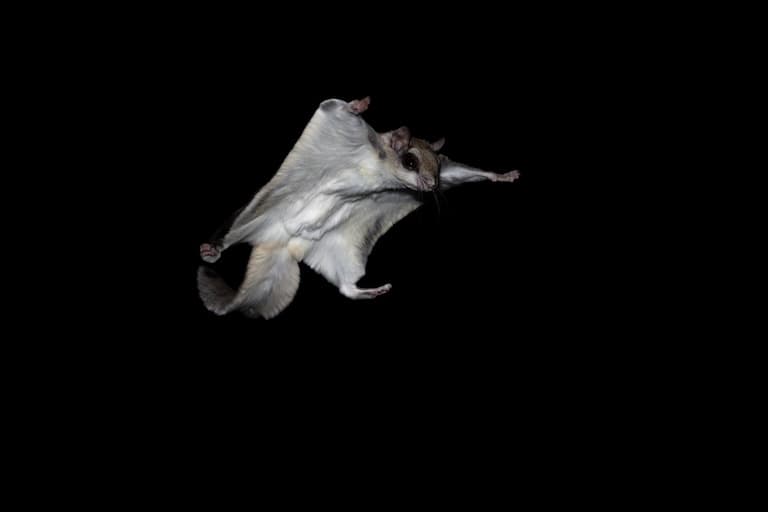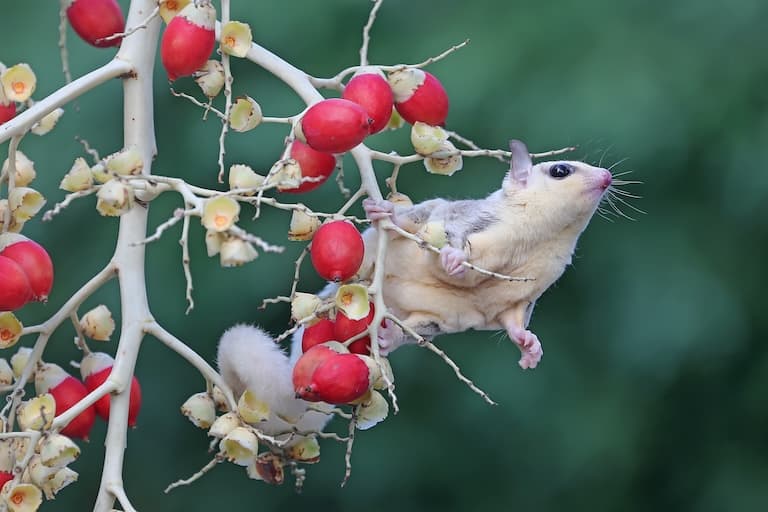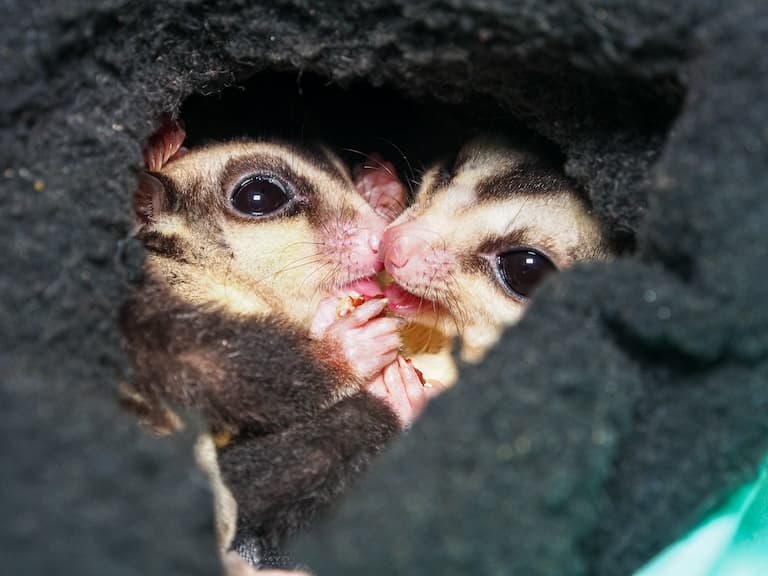Sugar Glider Profile
Australia is known for being a large island where snobbish Imperial Brits sent the rejects from society. And the animal life sort of reflects this: it’s a place where things that wouldn’t fit anywhere else appear to thrive.
On the ground, there are the macropods, hopping about on enormous feet. In the water, there are the monotremes, laying eggs and stabbing things with venomous toes. In the trees, there are koalas by day and possums by night.
One of these possums is an animal whose Latin name translates to “Short-headed rope dancer” in reference to its incredible feats of arboreal acrobatics: the sugar glider.

Sugar Glider Facts Overview
| Habitat: | Arboreal, forests |
| Location: | Australia, New Guinea |
| Lifespan: | 9 in the wild, 14 in captivity |
| Size: | 30 cm (12 in) from nose to tail |
| Weight: | Up to 115g (4 oz) |
| Colour: | Pale grey with dark stripes and a white belly |
| Diet: | Adaptive omnivores: sap, gum, leaves, fruits, insects, nectar, seeds, pollen |
| Predators: | Owls, kookaburras, goannas, and cats |
| Top Speed: | 40 km/g (25 mph) in a glide |
| No. of Species: | 1 |
| Conservation Status: | Least Concern (IUCN) |
Sugar gliders are painfully adorable tree-dwelling, nocturnal possums with a neat trick. When startled, they can throw themselves from the branch and open up a wing-like membrane that allows them to glide surprising distances and at impressive speed to safety.
They’re highly acrobatic, very social and impressively good fathers. But they should be left to live in the trees, where they’re at home.
Interesting Sugar Glider Facts
1. They’re possums
Sugar gliders are from the order of mammals that contain kangaroos and koalas. This makes them members of the primitive infraorder of mammals called marsupials. As such, they have pouches and are mostly herbivorous.
These gliders are one of 11 species of possum in the Petauridae family, are nocturnal, arboreal and suspiciously cute, like most other possums.
Unlike most other possums, though, they routinely base jump in wing suits. 1
2. They can glide
There’s a more famous mammal that does this, called the flying squirrel, and its claims of flight are far more exaggerated. The squirrel and the sugar glider look remarkably similar in this ability, though they evolved it totally independently, having been separated by at least 160 million years of evolution.
But neither can truly fly – both are just falling with finesse. They are gliding, which makes the sugar glider a lot more honest in its capabilities.
Sugar gliders, and other gliders, have a pair of membranes called pagaia. A patagium is what you find on a bat’s wing, too, and in the glider, it stretches between their front and rear limbs; from its wrists to its ankles, the sugar glider has a built-in wingsuit.
This is a fantastic way to avoid predators, and the little marsupial can glide over 45 meters horizontally when startled, landing in a totally different tree. So, that explains the second part of its name.
3. They’re pollinators

The first part of the name comes from this little cutie’s fondness for nectar. Sugar gliders eat many different things, from leafy greens and seeds to insects and even lizards and small birds, but they commonly visit flowers for both pollen and nectar.
This behaviour naturally makes them excellent pollinators and they’re likely to be significant contributors to the breeding success of various plants they visit.
4. They chew gum
Sugar gliders also love to eat tree sap or gum, which they access with their little teeth by stripping the bark from the tree and boring a hole in the wood.
They’ve evolved an extra large caecum in their intestines to help them digest these strange foods and enjoy their sap-sucking without getting indigestion.
While they’re doing this, they’ll ambush insects that pass by, but they generally leave the tiresome chasing for the true predators.
5. They sometimes hunt
When they are feeling energetic, they will occasionally predate actively, and sugar gliders have been known to kill and eat various spiders, moths, beetles, small birds, and of course, their eggs.
This incredibly diverse diet is well-balanced in the wild but can be tricky to replicate in captivity. Captive sugar gliders require a range of supplements to make sure they’re getting enough out of their diet.
6. They’re very social
Another element of wild glider life that can be tough to mimic is their sociality. Wild gliders live in family colonies of around seven animals and their young. There may be four generations within a single colony, and they all jump around enthusiastically and groom one another for hygiene and bonding.
There are usually two dominant males who share top responsibilities and keep the subordinates in order. They’re often brothers or otherwise close relatives and will share food, nests and mates in a sweet little bromance.
Dominance displays are commonly seen from dominants to subordinates or strangers, but in-group fights are very rare. The two males will mark out a territory of around 2.5 acres which they will defend and maintain by scent marking with saliva.
Sugar gliders communicate a lot, using both visual, audible and olfactory cues. They often bark, hiss, squeak and chitter to one another. 2 3
7. They’re good dads
Sugar glider males take great care of their young. This is something very unusual in mammal societies and makes them even cuter.
The oldest male will have plenty of offspring over the years and will show the most care towards the young, and mothers and fathers will take turns warming and cuddling with the babies while the other parent goes off to forage.
This is extremely important because the babies can’t control their own body temperatures until they’re over three months old. 4
8. They don’t make good pets
Sugar gliders are incredible, cute, funny and charismatic animals whose needs reflect the wealth of resources in the tropical jungles of Australia.
They do not do well in captivity and are wild animals. While they do breed in captivity, their needs are not easy to meet as a small-scale pet owner and require experienced keepers to look after well.
They are understandably sought after by private owners but should generally not be considered as an option for pets. 5
Sugar Glider Fact-File Summary
Scientific Classification
| Kingdom: | Animalia |
| Phylum: | Chordata |
| Class: | Marsupiala |
| Order: | Diprodontia |
| Family: | Petauridae |
| Genus: | Petaurus |
| Species: | breviceps |
Fact Sources & References
- “Sugar Glider”, San Diego Zoo Wildlife Alliance.
- “Sugar Glider”, Science Direct.
- “Sugar Glider Barking, Crabbing, & Other Noises – What Do They Mean?”, pocketpets.
- Ross L. Goldingay (2010), “Direct male parental care observed in wild sugar gliders”, Australian Mammalogy.
- (2020), “Do sugar gliders make good pets?”, World Animal Protection.

